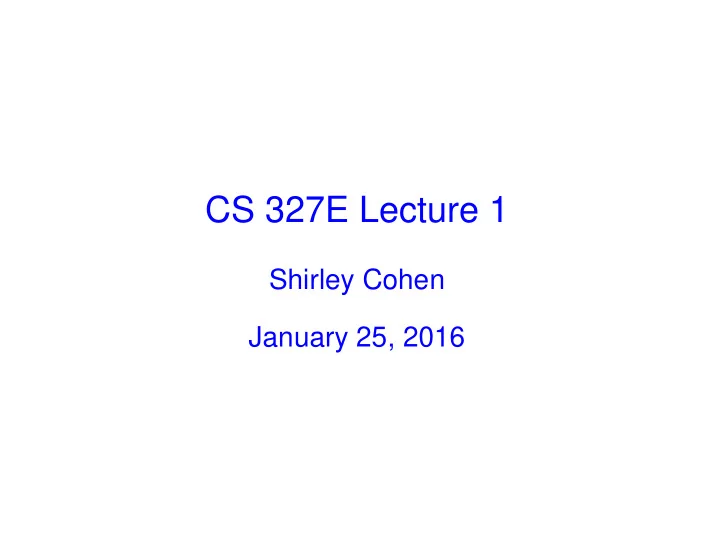

CS 327E Lecture 1 Shirley Cohen January 25, 2016
Agenda • Announcements • Homework for today • Reading Quiz • Concept Questions • Homework for next time
Announcements • Reading quizzes and class participation grades • Absences • Eric’s office hours will be Fridays 12:00pm - 2:00pm in GDC 2.112 • Daniel’s office hours will be Tuesdays 1:30pm - 3:00pm in GDC 3.302 • Please review Eric’s MySQL install instructions for OS X • Please go see Daniel or Eric during their office hours you are still not able to get MySQL server installed on your machine
Homework for Today • Read Chapter 2 from the Learning SQL book • Installed MySQL server on your machine • Created the bank database • Populated the bank database
Quiz Question 1 Although the text is system-agnostic, what relational database system is used in the examples of Beaulieu’s Learning SQL ? A. PostgreSQL B. MySQL C. Microsoft SQL Server D. Oracle Database
Quiz Question 2 What MySQL data type is used to store fixed-length strings? A. CHAR B. VARCHAR C. STRING D. STR
Quiz Question 3 Why would you choose a TIMESTAMP over a DATE type? A. TIMESTAMP is more precise than a DATE B. Only for representing the time C. TIMESTAMP is for representing a date and time (year, month, day, hour, minute, second) while DATE is for representing a date (year, month, day) D. Never — DATE should always be used instead of TIMESTAMP
Quiz Question 4 What SQL statement would you use to create a new row in a table? A. APPEND B. NEW C. INSERT D. ALTER
Quiz Question 5 Below is the output from executing a MySQL command: mysql> ?????????????? +-----------+----------------------+------+-----+---------+----------------+ | Field | Type | Null | Key | Default | Extra | +-----------+----------------------+------+-----+---------+----------------+ | branch_id | smallint(5) unsigned | NO | PRI | NULL | auto_increment | | name | varchar(20) | NO | | NULL | | | address | varchar(30) | YES | | NULL | | | city | varchar(20) | YES | | NULL | | | state | varchar(2) | YES | | NULL | | | zip | varchar(12) | YES | | NULL | | +-----------+----------------------+------+-----+---------+----------------+ What is the command that was executed? A. SHOW CUSTOMER; B. DESCRIBE CUSTOMER; C. SELECT * FROM CUSTOMER; D. UPDATE CUSTOMER;
Basic Concepts Relational model Product Relation / Entity / Table Field / Attribute / Column PName Price Category Manufacturer Row / Tuple / Record iPhone $119.99 Cellphone Apple Cell / Value Android $299.99 Cellphone Samsung Primary key Composite primary key iPad $149.99 Tablet Apple Foreign key iClicker $20.99 Classroom iClicker Constraint
Tables Explained A tuple = a record A table = a set of records The schema of a table is the table name and attributes A key is an attribute whose value is unique (by convention, we underline the key)
Common Data Types CHAR, VARCHAR INT DOUBLE, FLOAT DATE, DATETIME BLOB, CLOB
Constraint types NOT NULL constraint Unique constraint Primary and foreign key constraint Check constraint
Relationships between Tables One-to-many relationship One-to-one relationship Many-to-many relationship
Principle of Data Independence Physical data independence Logical data independence Examples: Adding / dropping a column Adding / dropping an index
SQL Introduction Standard language for querying and manipulating data S tructured Q uery L anguage Many standards out there: • ANSI SQL • SQL92 (a.k.a. SQL2) • SQL99 (a.k.a. SQL3) • Vendors support various subsets of these • What we discuss is common to all of them
Data Manipulation Language (DML) statements SELECT INSERT/UPDATE/DELETE Data Definition Language (DDL) statements CREATE/ALTER/DROP GRANT/REVOKE
Concept Question 1 How can Alice’s record be deleted from the Persons table? A. Delete Persons record create table Persons where person_id = 100 ( B. Delete Persons record person_id SMALLINT(4) PRIMARY KEY, first_name VARCHAR(20), where person_id = 100 and last_name VARCHAR(20), then delete Favorite_Music birth_date DATE records where person_id = ) 100 person_id first_name last_name birth_date C. Delete Favorite_Music 100 Alice Richardson 1990-05-01 200 Carter Willis 1982-01-27 records where person_id = 100 and then delete Persons records where create table Favorite_Music ( person_id = 100 song_id SMALLINT, D. Either B or C person_id SMALLINT, contraint pk_fav_music primary key (person_id, song_id), constraint fk_person_id foreign key (person_id) E. None of the above references Persons (person_id) ) song_id person_id 40 100 41 100
Homework for Next Time • Chapter 3 from the Learning SQL book • Exercises at the end of Chapter 3
Recommend
More recommend